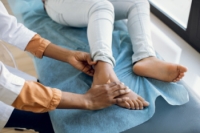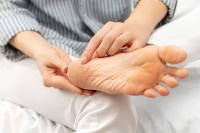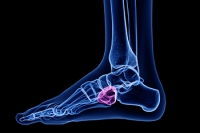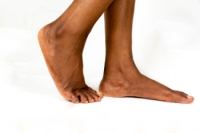
Blog (807)
Are Bunions Affecting Your Everyday Life?
Common Diagnostic Tests for Foot and Ankle Pain
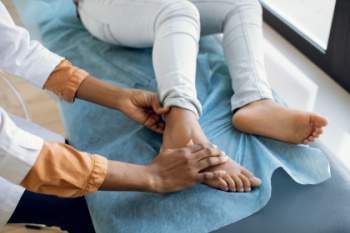
Common diagnostic tests for foot and ankle pain encompass a variety of methods aimed at identifying the underlying cause of discomfort and informing appropriate treatment strategies. X-rays are often the initial imaging choice, providing detailed views of bones to detect fractures, arthritis, or bone abnormalities. Magnetic Resonance Imaging, or MRI, offers more comprehensive images, particularly useful for soft tissue injuries, such as ligament tears or tendon damage. Ultrasound scans provide real-time imaging and are effective for assessing soft tissue structures like tendons and ligaments. CT scans may be used to visualize complex fractures or detailed bone structures. Additionally, diagnostic procedures like electromyography, EMG, and nerve conduction studies, NCS, help assess nerve function, aiding in the diagnosis of conditions like peripheral neuropathy or nerve compression syndromes. Physical examination techniques, including range of motion tests and palpation, complement these diagnostic tests, providing valuable insights into the source of foot and ankle pain. If you have foot or ankle pain, it is suggested that you make an appointment with a podiatrist who can examine you and conduct tests necessary to properly diagnose and treat you.
Foot Pain
Foot pain can be extremely painful and debilitating. If you have a foot pain, consult with Dr. Kenneth Donovan from Advanced Care Foot and Ankle. Our doctor will assess your condition and provide you with quality foot and ankle treatment.
Causes
Foot pain is a very broad condition that could be caused by one or more ailments. The most common include:
- Bunions
- Hammertoes
- Plantar Fasciitis
- Bone Spurs
- Corns
- Tarsal Tunnel Syndrome
- Ingrown Toenails
- Arthritis (such as Gout, Rheumatoid, and Osteoarthritis)
- Flat Feet
- Injury (from stress fractures, broken toe, foot, ankle, Achilles tendon ruptures, and sprains)
- And more
Diagnosis
To figure out the cause of foot pain, podiatrists utilize several different methods. This can range from simple visual inspections and sensation tests to X-rays and MRI scans. Prior medical history, family medical history, and any recent physical traumatic events will all be taken into consideration for a proper diagnosis.
Treatment
Treatment depends upon the cause of the foot pain. Whether it is resting, staying off the foot, or having surgery; podiatrists have a number of treatment options available for foot pain.
If you have any questions, please feel free to contact one of our offices located in Warren, Livingston, and Toms River, NJ . We offer the newest diagnostic and treatment technologies for all your foot care needs.
Podiatrists Can Manage Cracked Heels
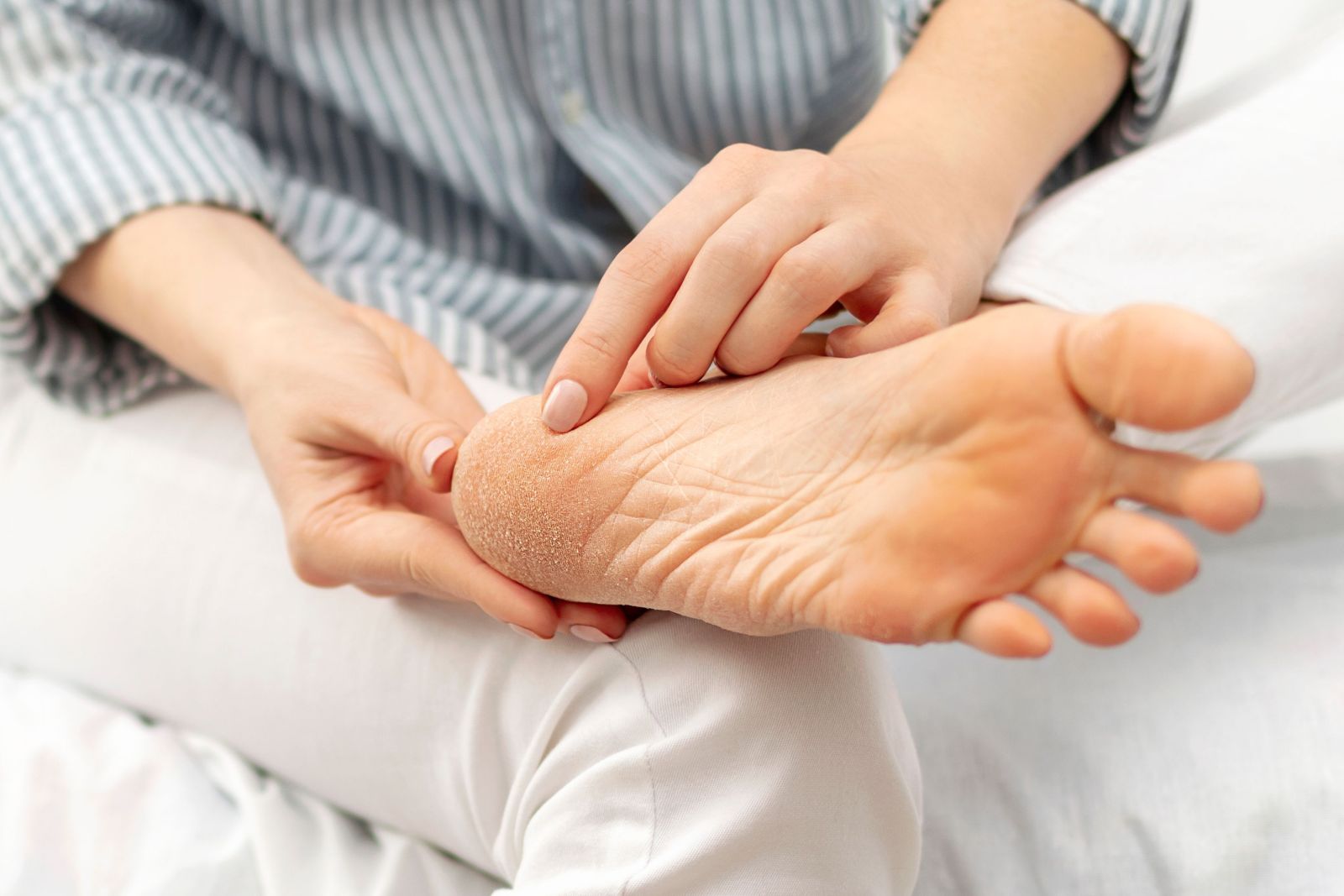
Cracked heels are a common foot condition characterized by fissures or splits in the skin, typically on the heels. They develop due to a combination of factors including dryness, pressure, and callus formation. Common causes include prolonged standing, wearing open-back shoes, obesity, and dry skin conditions like eczema or psoriasis. Besides being unattractive, cracked heels can become painful, especially if deep fissures form, leading to bleeding or infection risk. Calluses often accompany cracked heels, exacerbating discomfort. If left untreated, severe cases may lead to infections or difficulty while walking. Podiatrists are trained to diagnose and treat cracked heels effectively. They can remove thickened skin and calluses, offer advice on moisturizing and proper footwear, and address underlying conditions contributing to the problem. Additionally, they may recommend orthotic inserts to relieve pressure on the heels and prevent further cracking. If you have cracked heels that are painful or unsightly, it is suggested that you schedule an appointment with a podiatrist who can offer relief remedies.
If the skin on your feet starts to crack, you may want to see a podiatrist to find treatment. If you have any concerns, contact Dr. Kenneth Donovan from Advanced Care Foot and Ankle. Our doctor can provide the care you need to keep you pain-free and on your feet.
Cracked Heels
It is important to moisturize your cracked heels in order to prevent pain, bleeding, and infection. The reason cracked heels form is because the skin on the foot is too dry to support the immense pressure placed on them. When the foot expands, the dry skin on the foot begins to split.
Ways to Help Heal Them
- Invest in a good foot cream
- Try Using Petroleum Jelly
- Ease up on Soaps
- Drink Plenty of Water
Ways to Prevent Cracked Heels
- Moisturize After Showering
- Skip a Shower
- Keep Shower Water Lukewarm
- Don’t Scrub Your Feet
If you are unsure how to proceed in treating cracked heels, seek guidance from a podiatrist. Your doctor will help you with any questions or information you may need.
If you have any questions, please feel free to contact one of our offices located in Warren, Livingston, and Toms River, NJ . We offer the newest diagnostic and treatment technologies for all your foot care needs.
Cuboid Syndrome in Athletes
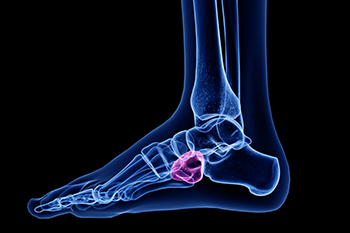 Cuboid syndrome is a prevalent source of lateral midfoot discomfort in athletes. It is thought that it might happen when there's a small problem with the joint in the middle of the foot. Symptoms closely resemble those of ligament sprains. Definitive diagnostic tests for the condition are currently unavailable. However, some studies show good responses to joint manipulation and external support. Despite the absence of evidence-based guidelines, diagnosing cuboid syndrome often relies on recognizing a combination of signs and symptoms. Manipulation of the cuboid is typically considered as an initial treatment option unless contraindicated. If you are an athlete and have persistent pain in your midfoot area, it is suggested that you make an appointment with a podiatrist to have your foot examined and a determination made as to whether cuboid syndrome might be the cause. Then, you can get the right treatment.
Cuboid syndrome is a prevalent source of lateral midfoot discomfort in athletes. It is thought that it might happen when there's a small problem with the joint in the middle of the foot. Symptoms closely resemble those of ligament sprains. Definitive diagnostic tests for the condition are currently unavailable. However, some studies show good responses to joint manipulation and external support. Despite the absence of evidence-based guidelines, diagnosing cuboid syndrome often relies on recognizing a combination of signs and symptoms. Manipulation of the cuboid is typically considered as an initial treatment option unless contraindicated. If you are an athlete and have persistent pain in your midfoot area, it is suggested that you make an appointment with a podiatrist to have your foot examined and a determination made as to whether cuboid syndrome might be the cause. Then, you can get the right treatment.
Cuboid syndrome, also known as cuboid subluxation, occurs when the joints and ligaments near the cuboid bone in the foot become torn. If you have cuboid syndrome, consult with Dr. Kenneth Donovan from Advanced Care Foot and Ankle. Our doctor will assess your condition and provide you with quality foot and ankle treatment.
Cuboid syndrome is a common cause of lateral foot pain, which is pain on the outside of the foot. The condition may happen suddenly due to an ankle sprain, or it may develop slowly overtime from repetitive tension through the bone and surrounding structures.
Causes
The most common causes of cuboid syndrome include:
- Injury – The most common cause of this ailment is an ankle sprain.
- Repetitive Strain – Tension placed through the peroneus longus muscle from repetitive activities such as jumping and running may cause excessive traction on the bone causing it to sublux.
- Altered Foot Biomechanics – Most people suffering from cuboid subluxation have flat feet.
Symptoms
A common symptom of cuboid syndrome is pain along the outside of the foot which can be felt in the ankle and toes. This pain may create walking difficulties and may cause those with the condition to walk with a limp.
Diagnosis
Diagnosis of cuboid syndrome is often difficult, and it is often misdiagnosed. X-rays, MRIs and CT scans often fail to properly show the cuboid subluxation. Although there isn’t a specific test used to diagnose cuboid syndrome, your podiatrist will usually check if pain is felt while pressing firmly on the cuboid bone of your foot.
Treatment
Just as the range of causes varies widely, so do treatments. Some more common treatments are ice therapy, rest, exercise, taping, and orthotics.
If you have any questions, please feel free to contact one of our offices located in Warren, Livingston, and Toms River, NJ . We offer the newest diagnostic and treatment technologies for all your foot care needs.
Are You Suffering From Ingrown Toenails?
Balancing Quality of Life and Functionality in Diabetes Management
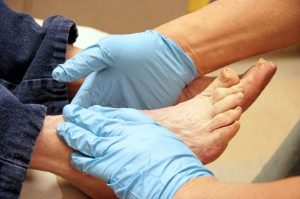
Diabetes raises the risk of foot ulcers, with a 40 percent five-year mortality rate. Limb salvage is preferred, but if a podiatrist finds that an amputation is necessary, partial-foot amputations, or PFAs, are preferred. PFAs offer better mobility and quality of life, but complications like re-ulceration persist. Assessing quality of life involves considering function and patient preferences. Shared decision-making integrates medical, psychological, and patient factors, which are critical for complex choices like limb salvage versus amputation. If you are a diabetic, it is strongly suggested that you make regular appointments with a podiatrist to have your feet routinely examined and problems dealt with as soon as possible. Preventing complications leading to limb-threatening conditions and improving quality of life is the goal.
Limb salvage can be an effective way in preventing the need for limb amputation. If you have diabetes, cancer, or any other condition that could lead to foot amputation if left unchecked, consult with Dr. Kenneth Donovan from Advanced Care Foot and Ankle. Our doctor will assess your condition and provide you with quality foot and ankle treatment.
What Is Limb Salvage?
Limb salvage is the attempt of saving a limb, such as the foot from amputation. Podiatrists also try to make sure that there is enough function in the foot after the salvage that it is still usable. Diabetes is the number one cause of non-traumatic amputations in the United States. Those with diabetes experience poor blood circulation, which prevents proper healing of an ulcer. If the ulcer is left uncheck, it could become infected, which could result in the need for amputation.
However, there are other causes as well, such as cancer and traumatic injury. Links between higher mortality rates and amputation have been found. This translates into higher healthcare costs, and a reduced quality of life and mobility for amputees. Podiatrists have attempted to increase the prevalence of limb salvage in an attempt to solve these issues.
Diagnosis and Treatment
Limb salvage teams have grown in recent years that utilize a number of different treatments to save the infected limb. This includes podiatrists that specialize in wound care, rehabilitation, orthotics, and surgery. Through a combination of these methods, limb salvage has been found to be an effective treatment for infected limbs, and as an alternative to amputation. Podiatrists will first evaluate the potential for limb salvage and determine if the limb can be saved or must be amputated.
If you have any questions, please feel free to contact one of our offices located in Warren, Livingston, and Toms River, NJ . We offer the newest diagnostic and treatment technologies for all your foot care needs.
Definition of Flat Feet

Flat feet, or fallen arches, can lead to discomfort and pain, affecting daily activities. Treatment options aim to alleviate symptoms and improve foot function. Custom-made orthotics to support the arch and provide cushioning, can help distribute pressure evenly and reduce pain. Wearing supportive footwear with proper arch support and shock absorption can also alleviate discomfort. Stretching exercises to strengthen the muscles and improve flexibility may be beneficial. In severe cases, corticosteroid injections may be recommended to reduce pain and inflammation. Surgery is rarely necessary, but may be considered for individuals with persistent pain and significant foot deformities. If you have pain from having flat feet, it is suggested that you schedule an appointment with a podiatrist for an evaluation and a plan tailored to your individual needs.
Flatfoot is a condition many people suffer from. If you have flat feet, contact Dr. Kenneth Donovan from Advanced Care Foot and Ankle. Our doctor will treat your foot and ankle needs.
What Are Flat Feet?
Flatfoot is a condition in which the arch of the foot is depressed and the sole of the foot is almost completely in contact with the ground. About 20-30% of the population generally has flat feet because their arches never formed during growth.
Conditions & Problems:
Having flat feet makes it difficult to run or walk because of the stress placed on the ankles.
Alignment – The general alignment of your legs can be disrupted, because the ankles move inward which can cause major discomfort.
Knees – If you have complications with your knees, flat feet can be a contributor to arthritis in that area.
Symptoms
- Pain around the heel or arch area
- Trouble standing on the tip toe
- Swelling around the inside of the ankle
- Flat look to one or both feet
- Having your shoes feel uneven when worn
Treatment
If you are experiencing pain and stress on the foot you may weaken the posterior tibial tendon, which runs around the inside of the ankle.
If you have any questions please feel free to contact one of our offices located in Warren, Livingston, and Toms River, NJ . We offer the newest diagnostic and treatment technologies for all your foot and ankle needs.
Polydactyly Versus Syndactyly in Congenital Foot Conditions
 Polydactyly and syndactyly are different congenital foot conditions that affect the development of the toes. Polydactyly occurs when there are extra toes on the foot. This condition can vary in severity. Some people having a small extra toe that may not cause significant issues. Others may have a fully formed extra toe that requires surgical removal for functional and cosmetic reasons. Conversely, syndactyly occurs when two or more toes are fused together. This condition ranges from partial fusion, where only the skin connects the toes, to complete fusion, where the bones are fused together. Syndactyly can affect adjacent toes or more distant toes. Polydactyly and syndactyly are generally treated surgically to restore normal toe alignment and function. If you or your child has a congenital foot condition, it is suggested you consult with a podiatrist for proper evaluation and tailored management options.
Polydactyly and syndactyly are different congenital foot conditions that affect the development of the toes. Polydactyly occurs when there are extra toes on the foot. This condition can vary in severity. Some people having a small extra toe that may not cause significant issues. Others may have a fully formed extra toe that requires surgical removal for functional and cosmetic reasons. Conversely, syndactyly occurs when two or more toes are fused together. This condition ranges from partial fusion, where only the skin connects the toes, to complete fusion, where the bones are fused together. Syndactyly can affect adjacent toes or more distant toes. Polydactyly and syndactyly are generally treated surgically to restore normal toe alignment and function. If you or your child has a congenital foot condition, it is suggested you consult with a podiatrist for proper evaluation and tailored management options.
Congenital foot problems require immediate attention to avoid future complications. If you have any concerns, contact Dr. Kenneth Donovan of Advanced Care Foot and Ankle. Our doctor can provide the care you need to keep you pain-free and on your feet.
Congenital foot problems are deformities affecting the feet, toes, and/or ankles that children are born with. Some of these conditions have a genetic cause while others just happen. Some specific foot ailments that children may be born with include clubfeet, polydactyly/macrodactyly, and cleft foot. There are several other foot anomalies that can occur congenitally. What all of these conditions have in common is that a child may experience difficulty walking or performing everyday activities, as well as trouble finding footwear that fits their foot deformity. Some of these conditions are more serious than others. Consulting with a podiatrist as early as possible will help in properly diagnosing a child’s foot condition while getting the necessary treatment underway.
What are Causes of Congenital Foot Problem?
A congenital foot problem is one that happens to a child at birth. These conditions can be caused by a genetic predisposition, developmental or positional abnormalities during gestation, or with no known cause.
What are Symptoms of Congenital Foot Problems?
Symptoms vary by the congenital condition. Symptoms may consist of the following:
- Clubfoot, where tendons are shortened, bones are shaped differently, and the Achilles tendon is tight, causing the foot to point in and down. It is also possible for the soles of the feet to face each other.
- Polydactyly, which usually consists of a nubbin or small lump of tissue without a bone, a toe that is partially formed but has no joints, or an extra toe.
- Vertical talus, where the talus bone forms in the wrong position causing other bones in the foot to line up improperly, the front of the foot to point up, and the bottom of the foot to stiffen, with no arch, and to curve out.
- Tarsal coalition, when there is an abnormal connection of two or more bones in the foot leading to severe, rigid flatfoot.
- Cleft foot, where there are missing toes, a V-shaped cleft, and other anatomical differences.
- Macrodactyly, when the toes are abnormally large due to overgrowth of the underlying bone or soft tissue.
Treatment and Prevention
While there is nothing one can do to prevent congenital foot problems, raising awareness and receiving neonatal screenings are important. Early detection by taking your child to a podiatrist leads to the best outcome possible.
If you have any questions please feel free to contact one of our offices located in Warren, Livingston, and Toms River, NJ . We offer the newest diagnostic tools and technology to treat your foot and ankle needs.
Do Your Child's Feet Hurt?
Scar Management of Foot Wounds
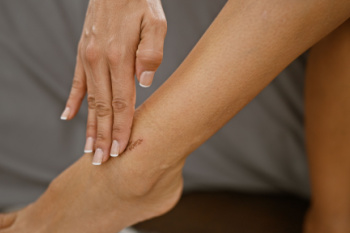
Properly caring for foot or ankle surgical scars is closely linked to the different stages of wound healing. When preparing a patient for surgery, it is important to consider factors that cannot be changed, such as age and any history of raised scars. To prevent scars from getting worse, the most important thing to control is the tightness of the wound during healing. This depends on how the surgical cut is made. Usually, cuts are made along the natural lines of the skin, but in some areas, there are no such lines. Taking care of a surgical scar does not stop when the stitches are removed, and it should continue for about a year. Podiatrists will keep checking the scar during follow-up visits to make sure it is not getting worse. If it starts to become raised and thick, steroid injections and other treatments can be used to help. If you are having foot or ankle surgery, it is suggested that you speak to a podiatrist about past wound healing
Wound care is an important part in dealing with diabetes. If you have diabetes and a foot wound or would like more information about wound care for diabetics, consult with Dr. Kenneth Donovan from Advanced Care Foot and Ankle. Our doctor will assess your condition and provide you with quality foot and ankle treatment.
What Is Wound Care?
Wound care is the practice of taking proper care of a wound. This can range from the smallest to the largest of wounds. While everyone can benefit from proper wound care, it is much more important for diabetics. Diabetics often suffer from poor blood circulation which causes wounds to heal much slower than they would in a non-diabetic.
What Is the Importance of Wound Care?
While it may not seem apparent with small ulcers on the foot, for diabetics, any size ulcer can become infected. Diabetics often also suffer from neuropathy, or nerve loss. This means they might not even feel when they have an ulcer on their foot. If the wound becomes severely infected, amputation may be necessary. Therefore, it is of the upmost importance to properly care for any and all foot wounds.
How to Care for Wounds
The best way to care for foot wounds is to prevent them. For diabetics, this means daily inspections of the feet for any signs of abnormalities or ulcers. It is also recommended to see a podiatrist several times a year for a foot inspection. If you do have an ulcer, run the wound under water to clear dirt from the wound; then apply antibiotic ointment to the wound and cover with a bandage. Bandages should be changed daily and keeping pressure off the wound is smart. It is advised to see a podiatrist, who can keep an eye on it.
If you have any questions, please feel free to contact one of our offices located in Warren, Livingston, and Toms River, NJ . We offer the newest diagnostic and treatment technologies for all your foot care needs.


